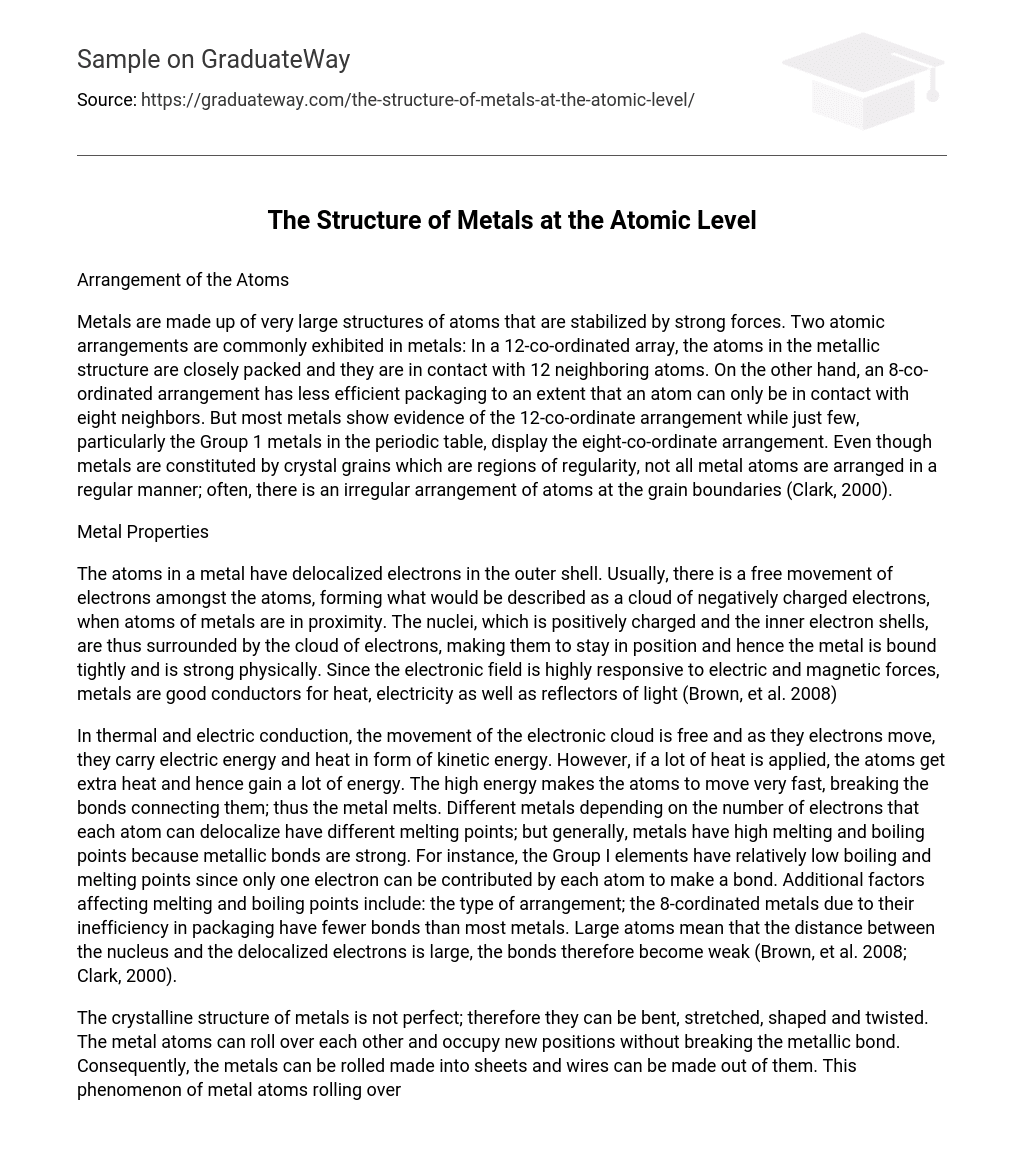Arrangement of the Atoms
Metals are made up of very large structures of atoms that are stabilized by strong forces. Two atomic arrangements are commonly exhibited in metals: In a 12-co-ordinated array, the atoms in the metallic structure are closely packed and they are in contact with 12 neighboring atoms. On the other hand, an 8-co-ordinated arrangement has less efficient packaging to an extent that an atom can only be in contact with eight neighbors. But most metals show evidence of the 12-co-ordinate arrangement while just few, particularly the Group 1 metals in the periodic table, display the eight-co-ordinate arrangement. Even though metals are constituted by crystal grains which are regions of regularity, not all metal atoms are arranged in a regular manner; often, there is an irregular arrangement of atoms at the grain boundaries (Clark, 2000).
Metal Properties
The atoms in a metal have delocalized electrons in the outer shell. Usually, there is a free movement of electrons amongst the atoms, forming what would be described as a cloud of negatively charged electrons, when atoms of metals are in proximity. The nuclei, which is positively charged and the inner electron shells, are thus surrounded by the cloud of electrons, making them to stay in position and hence the metal is bound tightly and is strong physically. Since the electronic field is highly responsive to electric and magnetic forces, metals are good conductors for heat, electricity as well as reflectors of light (Brown, et al. 2008)
In thermal and electric conduction, the movement of the electronic cloud is free and as they electrons move, they carry electric energy and heat in form of kinetic energy. However, if a lot of heat is applied, the atoms get extra heat and hence gain a lot of energy. The high energy makes the atoms to move very fast, breaking the bonds connecting them; thus the metal melts. Different metals depending on the number of electrons that each atom can delocalize have different melting points; but generally, metals have high melting and boiling points because metallic bonds are strong. For instance, the Group I elements have relatively low boiling and melting points since only one electron can be contributed by each atom to make a bond. Additional factors affecting melting and boiling points include: the type of arrangement; the 8-cordinated metals due to their inefficiency in packaging have fewer bonds than most metals. Large atoms mean that the distance between the nucleus and the delocalized electrons is large, the bonds therefore become weak (Brown, et al. 2008; Clark, 2000).
The crystalline structure of metals is not perfect; therefore they can be bent, stretched, shaped and twisted. The metal atoms can roll over each other and occupy new positions without breaking the metallic bond. Consequently, the metals can be rolled made into sheets and wires can be made out of them. This phenomenon of metal atoms rolling over each other is influenced by the grain boundaries for the reason that the alignment of the atoms in a row is not accurate. Thus, a metal will become hard if the grain boundaries are many, since the individual crystals are many. In addition, increase in grain boundaries makes the metals fracture at this point because atoms are not in good conduct with each other (Halmos, 2006).
Conclusion
The arrangement of atoms in metals with metallic bonds in between the atoms gives rise to a regular giant structure which is closely packed. The arrangement of the atoms is in two orientations: face-centered cubic structure and a cubic structure that is closely packed. A metal can only have one the aforementioned orientations. Electric and heat conductivity is made possible by the presence of free electrons in an atom. The free atoms also give malleability and ductility properties. Metals that have high melting points mean that strong metallic bonds exist within the metal atoms (Ohring, 1995).
References:
Brown, L, T, Brown, T, E & Murphy, C 2008, Chemistry: the central science, 11th Edition, ISBN 0132358484, 9780132358484, Pearson Education International.
Clark, J 2000, METALLIC STRUCTURE, retrieved on 5th March, 2009, from: http://www.chemguide.co.uk/atoms/structures/metals.html……..
Halmos, G, T 2006, Roll Forming Handbook, ISBN 0824795636, 9780824795634, CRC Press.
Ohring, M 1995, Engineering materials science, ISBN 0125249950, 9780125249959, Academic Press.





